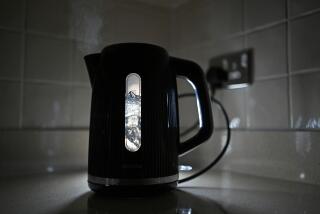Sewage Spill a Danger to Lake Hodges Water
- Share via
Two North County water districts were forced by water authorities to stop drawing water from Lake Hodges on Monday after more than 45,000 gallons of raw sewage spewed into the lake from a residential sewage line rupture.
The spill, believed to have started sometime Saturday in the southeast corner of the lake, went undetected until 7:30 p.m. Sunday and was not stopped until Monday afternoon, said Yvonne Rehg, public information director for the San Diego Water Utilities Department.
A sewage line in Thompson Creek Canyon clogged with grease and sewage solids forced sewage out of a manhole, through Sycamore Creek and into the lake at a rate of 50 gallons a minute, Rehg said.
Warning signs were posted around the area and repair crews stopped the flow of sewage--which officials estimated had lasted for at least 15 hours--by 10:30 Monday morning.
Although the spillage rate was called “very minimal” by Gary Stephany, director of county environmental services, he said the county health department ordered the San Dieguito and Sante Fe Irrigation water districts to stop drawing water from the lake at 2 a.m. Monday as a precautionary measure.
‘No Danger’ to Public
Stephany explained that the spill presented “no danger” to the public--primarily because the water drawn for drinking is more than six miles downstream from the spill site and the sewage would be absorbed before it reached that point.
As an added protection, Stephany said, drinking water drawn from the lake is continuously tested for bacteria by county health officials. No abnormal readings have been made since the spill began, he said.
Service to the area served by those districts, which includes Solana Beach and Encinitas, should not be drastically hampered because the two districts also obtain water from the California Aqueduct, said James Tolley, general manager for both districts. Until the health department approves use of the lake water again, the districts will increase their use of California Aqueduct water from the County Water Authority, Tolley said. However, that will cost $5,000 a day, Tolley added.
In April, the two water districts had their water supply cut when Lake Hodges was hit by a smaller spill--a blocked sewer main spilled about 3,000 gallons of sewage into the lake. That spill also occurred in Thompson Creek Canyon, said John Melbourne, a civil engineer with the health department.
“There could be several reasons why such problems are happening over there,” Melbourne said. “Somebody could be pouring down too much grease or it could be a result of vandalism.” The latter is a legitimate concern since vandals wrecked equipment that operated a sewage pump in Escondido in April. The vandalism not only caused about 200,000 gallons of raw sewage to spill into San Martin Creek in Kit Carson Park but also threatened Lake Hodges.
If problems continue near Lake Hodges, Melbourne said, the state Regional Water Quality Control Board will be asked to investigate.
No Threat to Lake
The spill should not pose any lasting threat to the lake--known as a vast wildlife refuge and a favorite site for bass fishing--Stephany said.
“Now, I don’t know the exact dimensions of the lake, but it’s very big,” he said. “The lake will be able to absorb the spill without any major concern of pollution. If the rate was 500 gallons per minute, then it would contaminate the drinking water supply and of course we would be concerned.”
In addition, Stephany said the recent reports of sewage spills in San Diego County, although seeming to appear frequently, should be of no serious concern to the public.
“The number of sewage spills we have been getting is nothing unusual,” Stephany said. “We’ve been getting as many spills as in the past. It’s just that before, we didn’t report every single spill to the media. Now, because of Proposition 65, we do.”
Proposition 65, which was passed by voters statewide in November, requires the health department to notify the media of any kind of hazardous spill. Until the proposition was passed, Stephany said, only spills that posed an immediate threat to the the public were reported.
More to Read
Sign up for Essential California
The most important California stories and recommendations in your inbox every morning.
You may occasionally receive promotional content from the Los Angeles Times.










